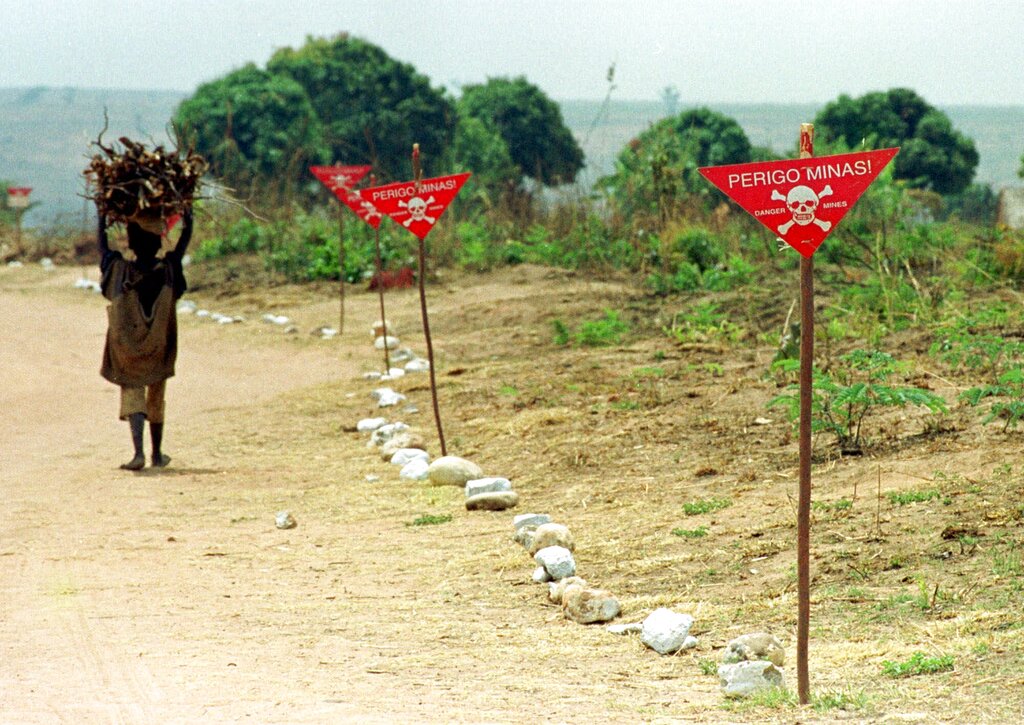Angola has made significant progress in clearing land mines and other unexploded ordnance left over from the country’s 27-year civil war. These efforts have made previously hazardous areas safe for agriculture, housing and community development projects, but work remains.
Angola’s Benguela and Huambo provinces are expected to be completely free of mines this year. Benguela is in western Angola on the Atlantic coast. Huambo is in central Angola.
Brig. Gen. Leonardo Severino Sapalo, Angola’s director-general of the National Mine Action Agency, spoke about the progress after a visit by a multicountry delegation of diplomats to see the work of Halo Trust, a United Kingdom nongovernment organization that has helped destroy more than 120,000 land mines in Angola since 1994.
About 975 minefields in the country still need to be cleared. Demining costs about $3.10 per square meter, and another $240 million is needed to complete the work, Sapalo said in a Reuters report.
About 192 of the remaining minefields are near the Benguela Railway that links Angola to neighboring countries such as the Democratic Republic of the Congo (DRC) and Zambia. Mine clearance along the railway will allow goods and services from Angola and other African countries to flow along the railway, while also enabling investment in road and rail infrastructure.
“The railway has been completely de-mined so that it can be rehabilitated,” Sapalo said in the Reuters report. “The train runs naturally, but there are specific areas that have not been completely cleared of mines. The work is not at a standstill, but we need to energize it.”
According to Halo Trust, the demining process along the Lobito Corridor has cleared 43,142 anti-personnel mines, 2,460 anti-tank mines and 235,050 other explosives.
Halo and other organizations from the U.K., as well as from Belgium, Japan and Norway, work with Angola’s National Commission on Demining and Humanitarian Assistance and National Demining Institute to eliminate minefields.
Minefields and other unexploded ordnance mostly are remnants from Angola’s civil war, which ended in 2002. Mines were laid sporadically by foreign and national actors in fields, villages and towns, killing and injuring thousands. According to the United Nations, about 15,000 civilians in Angola are killed or maimed by mines every year. The mines mostly were laid without proper marking or mapping, which complicates their removal.
The scourge has driven people from their homes, kept farmers from their fields and brought development to a standstill.
Demining work begins with surveys to identify minefields. Deminers then mark out blocks, clear undergrowth, and use metal detectors to identify and remove mines. Specially trained rats often are used to sniff out hidden explosives. The animals are lightweight, so they do not trigger the mines, and can quickly cover large areas.
Angola’s demining efforts initially focused on regional capitals and towns but now are mostly concentrated in rural areas in provinces surrounding the Lobito Corridor, including Cuando Kubango, Cuanza Sul, Lunda Norte, Lunda Sul and Moxico.
Halo’s community outreach teams also have visited villages near the town of Cuemba in central Angola’s Bié province to provide risk education classes. Explosive ordnance disposal teams respond when old shells, grenades and bombs are discovered.
Helena Kasongo, who works for Mines Advisory Group, is the mother of a young daughter and understands that children often are the victims of explosions. Kasongo recalled a 2023 incident in which a 6-year-old girl was killed and six others injured by an explosion in eastern Moxico province, which borders the DRC and Zambia. The children were playing with an unexploded bomb they found in a field.
“This is a story we all know too well,” Kasongo told the BBC. “There is nobody in Angola who doesn’t know someone who got injured. We need to stop this cycle for the good of our people and our nation.”
In August 2024, three children were killed and six injured after a grenade exploded in the province of Luanda, on the Atlantic coast in northern Angola. According to reports, the children found a hand grenade in a trash can in Cacuaco, about 20 kilometers from Luanda, the national capital. The grenade exploded seconds after one of the boys pulled the fuse.

